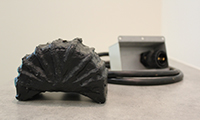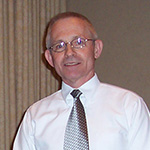OTT’s first disclosure from Charles “Chip” Epstein, MD related to his work with an iron core stimulation coil was received in the spring of 1995, with a second disclosure related to transcranial magnetic stimulation (TMS) coming along in late 1997. These were not only the early days for the technology but also the early days of our budding Tech Transfer office. The technology looked promising since it was both the first magnetic stimulator to utilize an iron core design which enabled improvements in power efficiency, heat generation, focal stimulation, and costs. Recognizing these benefits, OTT decided to pursue patent protection resulting in two primary patent families; one focused on stimulating the nervous system and the other on stimulating the brain.

These two disclosures formed the foundation of technologies licensed to two Emory start-ups Neotonus and Neuronetics and the winding path for a successful TMS treatment for depression began. Originally Neotonus licensed both patent families in late 1996 and launched into product development. The company’s primary focus was on their NeoControl system which was a non-surgical, non-invasive, painless treatment for female urinary incontinence also involving TMS. The system received FDA clearance in 2000.

When Neuronetics came along in 2001, it was an opportunity to split Chip’s two magnetic stimulation technologies between two companies, each working in the two differing fields of use. Following some negotiations, Neotonus agreed to return the patent rights to the transcranial magnetic stimulation technology. “It was good fortune for all involved that the two fields-of-use could be separated into two different patent families. Given the level of time, effort, and resources required for a start-up to get a product to market this allowed each company to narrow its focus; it was a “win-win-win” for everyone” recalls Orman Simpson the former case manager in OTT.
Once the rights and licenses had been sorted out, product development continued at Neuronetics ultimately leading to the NeuroStar TMS Therapy®. In 2004 the company embarked on its largest clinical trial at that time, using the device to treat major depressive disorder; in 2008 it received FDA clearance and in 2011 an insurance reimbursement code. “The staff were always joking and asking to try on the first TMS prototype which we affectionately referred to as the ‘helmet’ says Connie Newsome, program associate in OTT.

“In the end one of the elements that may have pushed TMS to success was an insurance reimbursement code allowing patients an opportunity for coverage” says Jennifer Sherer, former OTT case manager “because as you can imagine, if insurance isn’t going to pay for it, that limits the treatment and the impact.”
Technology transfer is a high risk, high reward business, it’s more than just evaluating technology, filing for patents, marketing, and negotiating an agreement. “So often the focus is on getting the deal, and yes, that is a critical component, but the real work starts after the license” says Cale Lennon, current OTT case manager. Following licensing and throughout the development process, the University, OTT, Chip, and Neuronetics continued to work together supporting various parts of the process of getting a product to market.
“The experience reminded me that technology transfer from the university into commercial reality is far more than just licensing. It’s easy to get caught up in the art of negotiating and crafting the agreement, but technology transfer is a people thing. What I remember most were all of the discussions with each of the parties involved and how they all worked through the process with me in a very helpful, positive, and cooperative way” says Simpson.
Almost every success story involves a long and winding road, and this one was no different. When universities license to a commercial partner, the discovery is not ready for the market; there are many years of additional research and development layered on top of that basic scientific breakthrough. In this case it took two start-ups, half a dozen agreements, 13 patent applications, and more than a decade to be successfully treating patients.
“In technology transfer you work with a lot of really interesting technology but unfortunately a lot of it doesn’t make it to the market, so seeing something make it thru and impact people’s lives is incredibly fulfilling, even when you’ve only played a very small part, as we have” says Sherer. “It’s just a bonus when the inventor is someone as passionate and supportive as Chip.”
There are six videos on the Emory’s TMS technology listed below:
-
Video Playlist:http://bit.ly/1mGx3IV
-
Depression, TMS & Emory:http://bit.ly/1kMsKui
-
Depression and its Stigma: http://bit.ly/1JuvKah
-
How does TMS Work and Feel:http://bit.ly/1O5qUPK
-
The Difference Between ETC and TMS:http://bit.ly/1UwKUMP
-
Martha Rhodes, Interview by Todd Sherer:http://bit.ly/1Z5ZvQE
-
Martha Rhodes Presentation, Sharing her Story of Depression and TMS:http://bit.ly/1mCxbcM
This piece is one in a series of four blogs related to Emory’s TMS technology. They look at the development and management of the technology, its impact, and this project from several points of view.
-
The Magic of Science and How TMS Saved Me, by Martha Rhodes: http://bit.ly/1JXRqGR
-
It Started in My Basement, Now it Improves Patients Lives, Interview with Chip Epstein: http://bit.ly/1PNUlIm
-
The Personal Side of a Tech Transfer Patient Video, by Linda Kesselring: http://bit.ly/1Z9cEO5